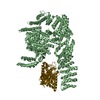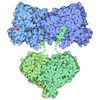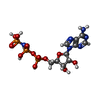[English] 日本語
 Yorodumi
Yorodumi- PDB-8rcn: CryoEM structure of mTORC1 with a paediatric kidney cancer-associ... -
+ Open data
Open data
- Basic information
Basic information
| Entry | Database: PDB / ID: 8rcn | ||||||||||||
|---|---|---|---|---|---|---|---|---|---|---|---|---|---|
| Title | CryoEM structure of mTORC1 with a paediatric kidney cancer-associated 1455-EWED-1458 duplication in mTOR, Focused region of mTOR and RAPTOR on one protomer copy. | ||||||||||||
 Components Components |
| ||||||||||||
 Keywords Keywords | SIGNALING PROTEIN / Target of Rapamycin / mTOR / Cancer-associated mutants | ||||||||||||
| Function / homology |  Function and homology information Function and homology informationRNA polymerase III type 2 promoter sequence-specific DNA binding / RNA polymerase III type 1 promoter sequence-specific DNA binding / positive regulation of cytoplasmic translational initiation / Activation of the mRNA upon binding of the cap-binding complex and eIFs, and subsequent binding to 43S / T-helper 1 cell lineage commitment / positive regulation of pentose-phosphate shunt / regulation of locomotor rhythm / positive regulation of wound healing, spreading of epidermal cells / eukaryotic initiation factor 4E binding / TORC2 complex ...RNA polymerase III type 2 promoter sequence-specific DNA binding / RNA polymerase III type 1 promoter sequence-specific DNA binding / positive regulation of cytoplasmic translational initiation / Activation of the mRNA upon binding of the cap-binding complex and eIFs, and subsequent binding to 43S / T-helper 1 cell lineage commitment / positive regulation of pentose-phosphate shunt / regulation of locomotor rhythm / positive regulation of wound healing, spreading of epidermal cells / eukaryotic initiation factor 4E binding / TORC2 complex / cellular response to leucine starvation / TFIIIC-class transcription factor complex binding / regulation of membrane permeability / heart valve morphogenesis / negative regulation of lysosome organization / nucleus localization / RNA polymerase III type 3 promoter sequence-specific DNA binding / TORC1 complex / positive regulation of transcription of nucleolar large rRNA by RNA polymerase I / calcineurin-NFAT signaling cascade / regulation of osteoclast differentiation / voluntary musculoskeletal movement / TORC1 signaling / positive regulation of odontoblast differentiation / positive regulation of keratinocyte migration / cellular response to L-leucine / Amino acids regulate mTORC1 / MTOR signalling / cellular response to nutrient / cellular response to methionine / Energy dependent regulation of mTOR by LKB1-AMPK / regulation of autophagosome assembly / energy reserve metabolic process / negative regulation of cell size / ruffle organization / positive regulation of osteoclast differentiation / cellular response to osmotic stress / protein serine/threonine kinase inhibitor activity / enzyme-substrate adaptor activity / anoikis / cardiac muscle cell development / negative regulation of protein localization to nucleus / positive regulation of transcription by RNA polymerase III / negative regulation of calcineurin-NFAT signaling cascade / regulation of myelination / positive regulation of actin filament polymerization / regulation of cell size / negative regulation of macroautophagy / positive regulation of oligodendrocyte differentiation / lysosome organization / Macroautophagy / positive regulation of myotube differentiation / protein kinase activator activity / behavioral response to pain / oligodendrocyte differentiation / Constitutive Signaling by AKT1 E17K in Cancer / mTORC1-mediated signalling / germ cell development / CD28 dependent PI3K/Akt signaling / : / social behavior / HSF1-dependent transactivation / positive regulation of TOR signaling / neuronal action potential / response to amino acid / TOR signaling / 'de novo' pyrimidine nucleobase biosynthetic process / endomembrane system / regulation of macroautophagy / positive regulation of G1/S transition of mitotic cell cycle / positive regulation of translational initiation / cellular response to nutrient levels / positive regulation of lamellipodium assembly / phosphorylation / phagocytic vesicle / positive regulation of lipid biosynthetic process / heart morphogenesis / positive regulation of epithelial to mesenchymal transition / cardiac muscle contraction / regulation of cellular response to heat / translation repressor activity / positive regulation of stress fiber assembly / negative regulation of translational initiation / cytoskeleton organization / 14-3-3 protein binding / positive regulation of endothelial cell proliferation / T cell costimulation / translation initiation factor binding / cellular response to starvation / cellular response to amino acid starvation / post-embryonic development / positive regulation of glycolytic process / positive regulation of mitotic cell cycle / negative regulation of autophagy / response to nutrient / response to nutrient levels / VEGFR2 mediated vascular permeability / regulation of signal transduction by p53 class mediator / positive regulation of peptidyl-threonine phosphorylation / Regulation of PTEN gene transcription Similarity search - Function | ||||||||||||
| Biological species |  Homo sapiens (human) Homo sapiens (human) | ||||||||||||
| Method | ELECTRON MICROSCOPY / single particle reconstruction / cryo EM / Resolution: 3.1 Å | ||||||||||||
 Authors Authors | Anandapadamanaban, M. / Hay, I.M. / Perisic, O. / Williams, R.L. | ||||||||||||
| Funding support |  United Kingdom, European Union, 3items United Kingdom, European Union, 3items
| ||||||||||||
 Citation Citation |  Journal: To Be Published Journal: To Be PublishedTitle: CryoEM structure of mTORC1 with a paediatric kidney cancer-associated 1455-EWED-1458 duplication in mTOR, Focused region of mTOR and RAPTOR on one protomer copy. Authors: Anandapadamanaban, M. / Hay, I.M. / Perisic, O. / Williams, R.L. | ||||||||||||
| History |
|
- Structure visualization
Structure visualization
| Structure viewer | Molecule:  Molmil Molmil Jmol/JSmol Jmol/JSmol |
|---|
- Downloads & links
Downloads & links
- Download
Download
| PDBx/mmCIF format |  8rcn.cif.gz 8rcn.cif.gz | 937.4 KB | Display |  PDBx/mmCIF format PDBx/mmCIF format |
|---|---|---|---|---|
| PDB format |  pdb8rcn.ent.gz pdb8rcn.ent.gz | 604.6 KB | Display |  PDB format PDB format |
| PDBx/mmJSON format |  8rcn.json.gz 8rcn.json.gz | Tree view |  PDBx/mmJSON format PDBx/mmJSON format | |
| Others |  Other downloads Other downloads |
-Validation report
| Summary document |  8rcn_validation.pdf.gz 8rcn_validation.pdf.gz | 1.5 MB | Display |  wwPDB validaton report wwPDB validaton report |
|---|---|---|---|---|
| Full document |  8rcn_full_validation.pdf.gz 8rcn_full_validation.pdf.gz | 1.5 MB | Display | |
| Data in XML |  8rcn_validation.xml.gz 8rcn_validation.xml.gz | 67.5 KB | Display | |
| Data in CIF |  8rcn_validation.cif.gz 8rcn_validation.cif.gz | 103.5 KB | Display | |
| Arichive directory |  https://data.pdbj.org/pub/pdb/validation_reports/rc/8rcn https://data.pdbj.org/pub/pdb/validation_reports/rc/8rcn ftp://data.pdbj.org/pub/pdb/validation_reports/rc/8rcn ftp://data.pdbj.org/pub/pdb/validation_reports/rc/8rcn | HTTPS FTP |
-Related structure data
| Related structure data |  19056MC M: map data used to model this data C: citing same article ( |
|---|---|
| Similar structure data | Similarity search - Function & homology  F&H Search F&H Search |
- Links
Links
- Assembly
Assembly
| Deposited unit | 
|
|---|---|
| 1 |
|
- Components
Components
| #1: Protein | Mass: 289257.969 Da / Num. of mol.: 1 Source method: isolated from a genetically manipulated source Source: (gene. exp.)  Homo sapiens (human) / Gene: MTOR, FRAP, FRAP1, FRAP2, RAFT1, RAPT1 / Production host: Homo sapiens (human) / Gene: MTOR, FRAP, FRAP1, FRAP2, RAFT1, RAPT1 / Production host:  Homo sapiens (human) Homo sapiens (human)References: UniProt: P42345, non-specific serine/threonine protein kinase | ||
|---|---|---|---|
| #2: Protein | Mass: 149200.016 Da / Num. of mol.: 1 Source method: isolated from a genetically manipulated source Source: (gene. exp.)  Homo sapiens (human) / Gene: RPTOR, KIAA1303, RAPTOR / Production host: Homo sapiens (human) / Gene: RPTOR, KIAA1303, RAPTOR / Production host:  Homo sapiens (human) / References: UniProt: Q8N122 Homo sapiens (human) / References: UniProt: Q8N122 | ||
| #3: Protein | Mass: 12592.968 Da / Num. of mol.: 1 Source method: isolated from a genetically manipulated source Source: (gene. exp.)  Homo sapiens (human) / Gene: EIF4EBP1 / Production host: Homo sapiens (human) / Gene: EIF4EBP1 / Production host:  | ||
| #4: Chemical | ChemComp-ANP / | ||
| #5: Chemical | | Has ligand of interest | Y | |
-Experimental details
-Experiment
| Experiment | Method: ELECTRON MICROSCOPY |
|---|---|
| EM experiment | Aggregation state: PARTICLE / 3D reconstruction method: single particle reconstruction |
- Sample preparation
Sample preparation
| Component | Name: mTORC1 complex is a dimer of a heterotrimeric complex including mTOR, RAPTOR and mLST8. Type: COMPLEX Details: This paediatric kidney cancer-associated mTORC1 variant consists of mTOR 1455-EWED-1458 duplication, RAPTOR and mLST8 complex and its bound to a substrate 4EBP1. Entity ID: #1-#3 / Source: RECOMBINANT |
|---|---|
| Molecular weight | Experimental value: NO |
| Source (natural) | Organism:  Homo sapiens (human) Homo sapiens (human) |
| Source (recombinant) | Organism:  Homo sapiens (human) Homo sapiens (human) |
| Buffer solution | pH: 7.5 |
| Specimen | Conc.: 0.6 mg/ml / Embedding applied: NO / Shadowing applied: NO / Staining applied: NO / Vitrification applied: YES |
| Vitrification | Instrument: FEI VITROBOT MARK IV / Cryogen name: ETHANE / Humidity: 95 % |
- Electron microscopy imaging
Electron microscopy imaging
| Experimental equipment |  Model: Titan Krios / Image courtesy: FEI Company |
|---|---|
| Microscopy | Model: FEI TITAN KRIOS |
| Electron gun | Electron source:  FIELD EMISSION GUN / Accelerating voltage: 300 kV / Illumination mode: FLOOD BEAM FIELD EMISSION GUN / Accelerating voltage: 300 kV / Illumination mode: FLOOD BEAM |
| Electron lens | Mode: BRIGHT FIELD / Nominal defocus max: 3000 nm / Nominal defocus min: 1200 nm / Cs: 2.7 mm |
| Image recording | Electron dose: 50 e/Å2 / Film or detector model: GATAN K3 BIOQUANTUM (6k x 4k) |
- Processing
Processing
| EM software | Name: EPU / Category: image acquisition | ||||||||||||||||||||||||
|---|---|---|---|---|---|---|---|---|---|---|---|---|---|---|---|---|---|---|---|---|---|---|---|---|---|
| CTF correction | Type: NONE | ||||||||||||||||||||||||
| Symmetry | Point symmetry: C1 (asymmetric) | ||||||||||||||||||||||||
| 3D reconstruction | Resolution: 3.1 Å / Resolution method: FSC 0.143 CUT-OFF / Num. of particles: 178379 / Algorithm: FOURIER SPACE Details: To obtain high-resolution details, the focused refinement of mTOR and RAPTOR region was performed on paediatric kidney cancer-associated mTORC1 variant consists of mTOR 1455-EWED-1458 ...Details: To obtain high-resolution details, the focused refinement of mTOR and RAPTOR region was performed on paediatric kidney cancer-associated mTORC1 variant consists of mTOR 1455-EWED-1458 duplication, RAPTOR and mLST8 complex and its bound to a substrate 4EBP1. Num. of class averages: 3 / Symmetry type: POINT | ||||||||||||||||||||||||
| Atomic model building | B value: 98.5 / Protocol: FLEXIBLE FIT / Space: REAL / Target criteria: cross-correlation coefficient Details: Initial local fitting was done in Coot and Chimera and then subjected to ROSETTA for model rebuilding. Finally, in Phenix real-space refine was performed for the final model | ||||||||||||||||||||||||
| Refinement | Cross valid method: NONE Stereochemistry target values: GeoStd + Monomer Library + CDL v1.2 | ||||||||||||||||||||||||
| Displacement parameters | Biso mean: 98.45 Å2 | ||||||||||||||||||||||||
| Refine LS restraints |
|
 Movie
Movie Controller
Controller




 PDBj
PDBj


























